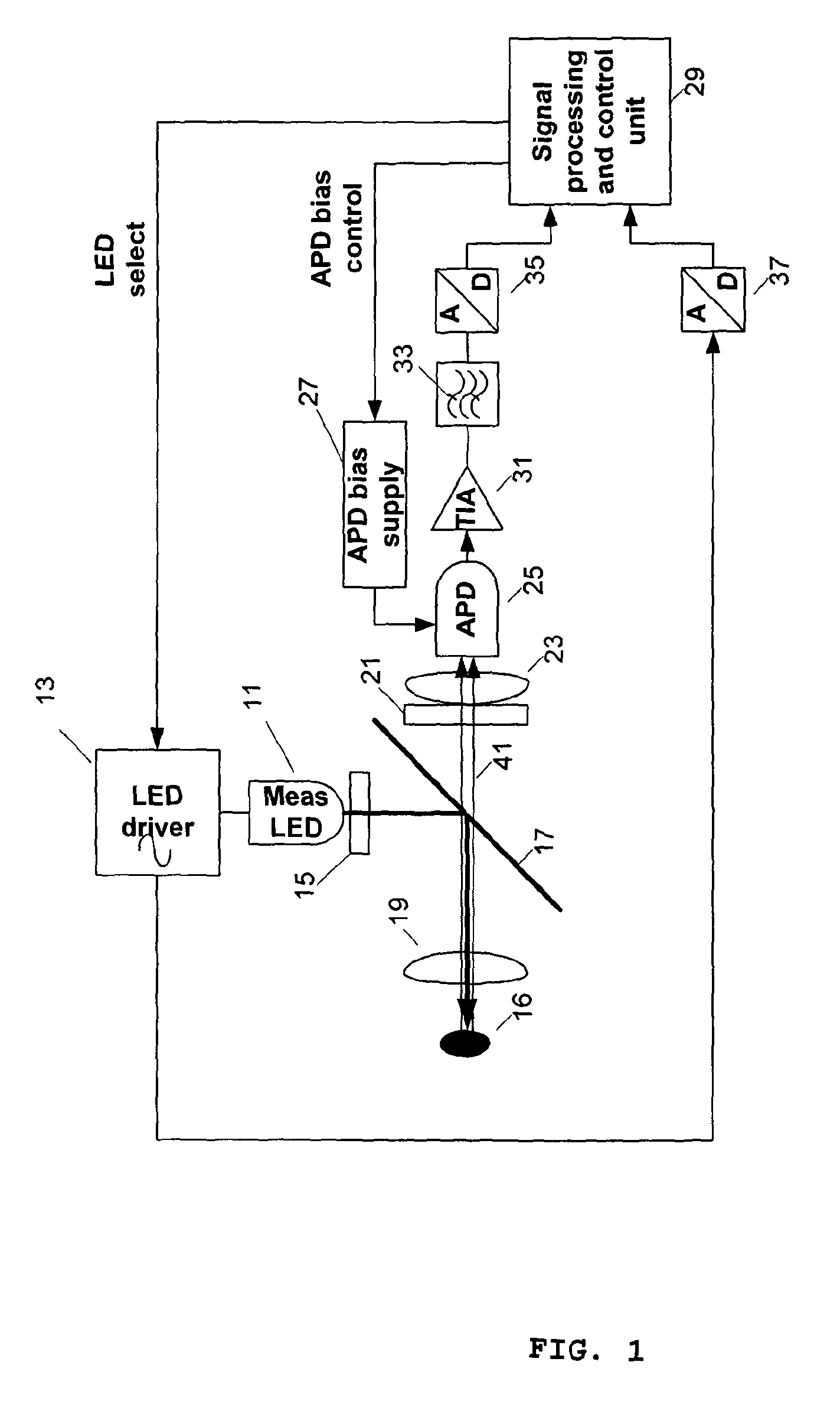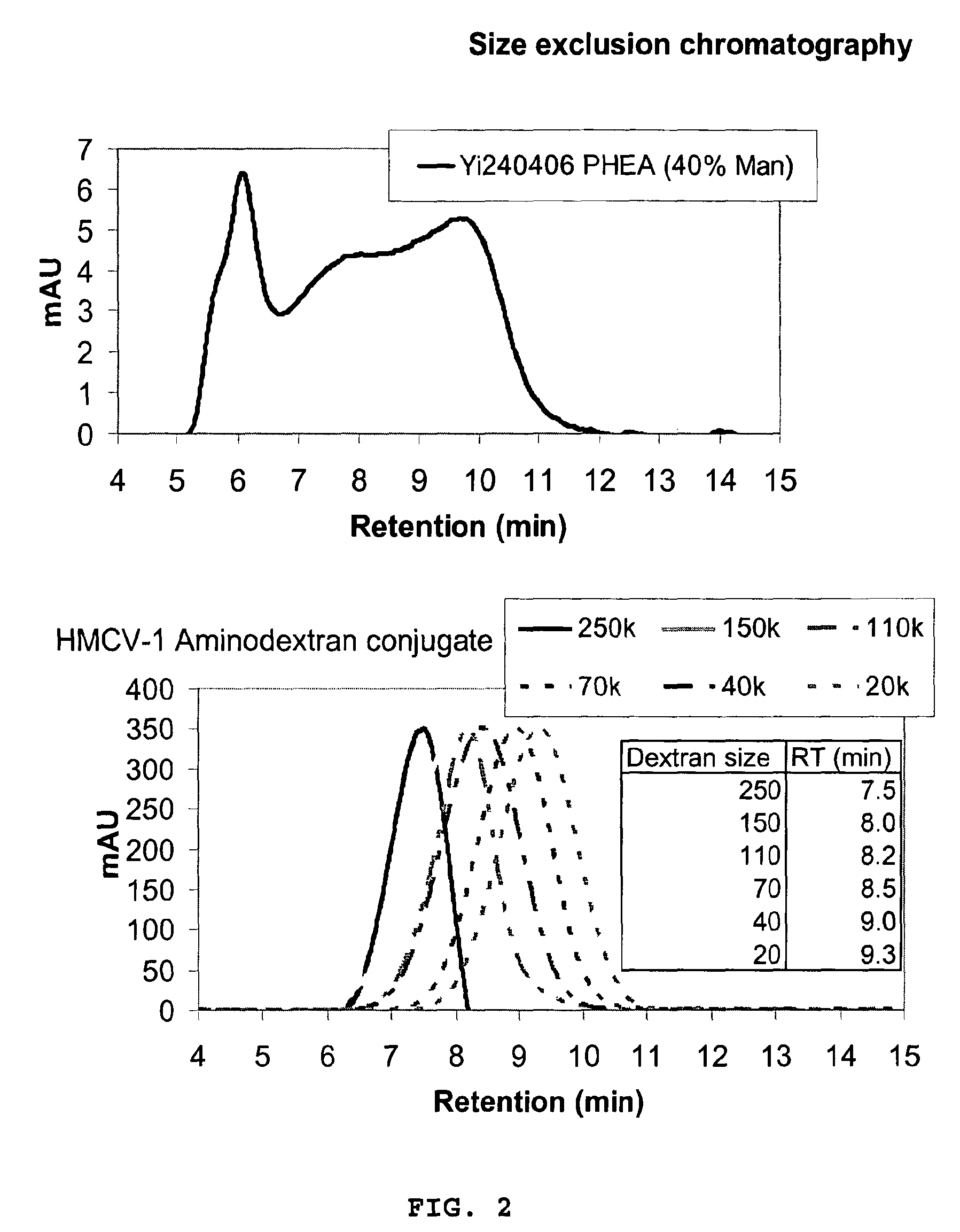Flexible Carbohydrate-Bearing Polymer
a polymer and flexible technology, applied in the field of polymer bearing carbohydrate or carbohydrate mimetic moieties, can solve the problems of increasing the frequency of blood glucose testing, imposing a considerable burden on the diabetic patient, and reducing the intensity or lifetime of the donor,
- Summary
- Abstract
- Description
- Claims
- Application Information
AI Technical Summary
Benefits of technology
Problems solved by technology
Method used
Image
Examples
example a1
Staining of MBL
[0252]Human MBL was buffer changed (by dialysis) to a 10 mM NaHCO3 buffer containing 150 mM NaCl and 1.25 mM Ca2+, pH 8.7. The dye used for staining was Alexa Fluor™ 594 succinimidyl ester (AF594-SE) (Molecular Probes, Eugene, Oreg., USA). The dye was dissolved in dry DMSO and added slowly (10 min.) to the MBL in bicarbonate buffer. Reaction was allowed to take place for 1 hour. The staining was performed with 15 times molar excess (with respect to the polypeptide unit) of dye. Purification was carried out by dialysis against 10 mM Tris buffer pH 7.4, 150 mM NaCl and 1.25 mM Ca2+. The obtained molar-based degree of labelling of the stained protein was determined by UV spectroscopy as 2.3 dyes per subunit of MBL (calculated using 28 kDa as molecular weight of MBL subunit).
example a2
Preparation of Dextran
[0253]150 kDa Dextran (6.00 g, 0.4 μmol) was dissolved in 250 mM K2HPO4 pH 11.5 (600 mL). Sodium borohydride (3 g, 0.08 mol) was added followed by the addition of divinylsulfone (15 ml, 0.15 mol). The reaction mixture was stirred for 30 min at RT, before neutralization to pH 7.2 with conc. HCl. After 30 min stirring, the resulting mixture was dialysed (MWCO 10-12 kDa) in water (3×25 L). The contents were transferred to an Erlenmeyer flask and 24% ammonia (200 mL) was added. After 2 h, the pH was adjusted to 10.5, and the reaction was stirred overnight. Excess ammonia was removed by dialysis (MWCO 10-12 k) in water (8×25 L), and the entire contents were lyophilised to yield the aminodextran 5.75 g (78%, based on an aminodextran MW of 185 kDa) as a white fluffy substance. Elemental analysis was used to make a rough estimate of the molecular weight, amine incorporation, and amount of incorporated divinylsulfone. (Found C, 39.86; H, 6.26; N, 0.16; S, 3.08%. Dextran...
example a3
Preparation of Hexa-Methoxy-Crystal Violet Succinimidyl Ester (HMCV-1)
Synthesis of HMCV-1:
[0254]
[0255]4a (BF4−): 4-(methylamino)butyric acid hydrochloride (1.36 g; 8.8 mmol), 1 (5.0 g; 8.3 mmol), and diisopropylethylamine (5 mL) was dissolved in acetonitrile (120 mL). The reaction mixture was stirred at 30-35° C. in a dry nitrogen atmosphere for 22 h. Aqueous dimethylamine (40 mL of a 40% solution) was added and the reaction mixture was stirred for four more days. Solvent and excess dimethylamine were removed in vacuo and the remaining material dissolved in chloroform. The chloroform solution was washed twice with brine and dried over MgSO4 before evaporation of the solvent and reprecipitation of the product from CH2Cl2 / ether. Yield: 4.4 g (70%) of a dark blue powder.
[0256]MS (FAB+): m / z 624 (M+)
[0257]1H-NMR (400 MHz, DMSO-d6): δ 8.34 (1H, bs), 6.03 (2H, s), 5.83 (4H, s), 3.49 (2H, m), 3.46 (6H, s), 3.44 (12H, s), 3.12 (3H, s (masked)), 3.08 (12H, s), 1.94 (2H, t), 1.70 (2H, m).
[025...
PUM
| Property | Measurement | Unit |
|---|---|---|
| mol % | aaaaa | aaaaa |
| mol % | aaaaa | aaaaa |
| molecular weight | aaaaa | aaaaa |
Abstract
Description
Claims
Application Information
 Login to View More
Login to View More - R&D
- Intellectual Property
- Life Sciences
- Materials
- Tech Scout
- Unparalleled Data Quality
- Higher Quality Content
- 60% Fewer Hallucinations
Browse by: Latest US Patents, China's latest patents, Technical Efficacy Thesaurus, Application Domain, Technology Topic, Popular Technical Reports.
© 2025 PatSnap. All rights reserved.Legal|Privacy policy|Modern Slavery Act Transparency Statement|Sitemap|About US| Contact US: help@patsnap.com



